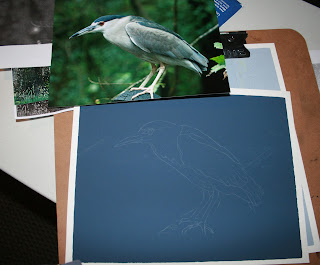Part 2
Supporting the Art.
There are many, many surfaces you can use for colored
pencil.
Anything you can drawing is valid.
You can draw on paper, wood, copper, velum, tiles. There are
few surfaces, however design with colored pencil in mind. Many multi-media
papers list colored paper among the media acceptable, but many are actually
difficult to use.
What you choose depends totally on the end results you wish.

Just about any surface that will accept charcoal or pastels
has enough tooth to use. One consideration is just how much it can take.
Charcoal papers tend to be thinner, lighter than pastel.
With all the layering most Colored pencil artist do, most charcoal and even
standard drawing papers tend to be too light and thin to take it.
Heavier pastel papers work well, and toned papers lend
themselves to dramatic results.
I have been using Colourfix toned pastel papers for my more recent colored pencil pieces. They help to set the tone of the pieces, as well as providing excellent tooth and support for colored pencil. The rough, sandpaper finish provided more than enough tooth to hold multiple layers of colored pencil, and allowing the work and rework of the medium. It is also thick enough to allow the use of watercolor pencils, water, and solvent washes. All in all. a good choice.
For the Heron, I want the bird to stand out against the dim background, very similar to the mood of the location when I photographed the bird. It was in a dense forest setting, rather dim. And I want this feeling to come through the drawing.

For the landscape, I really want the humid, overgrown nature of the landscape to be highlighted. The medium toned paper will set the tone of the light, allowing me to go both darker and lighter. The photo was taken at the Brookgreen Gardens in North Carolina. Here, Many of the iconic plants of the south are on display.








